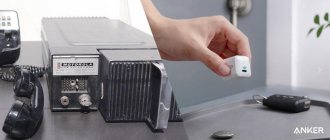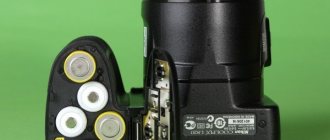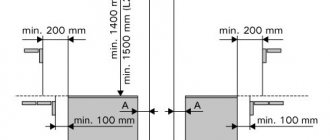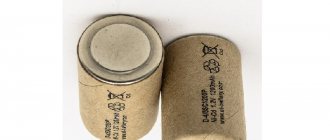Currently, li ion batteries and Li-pol (lithium polymer) batteries are widely used.
The difference between them is the electrolyte. In the first option, helium is used as it, in the second - a polymer saturated with a solution containing lithium. Today, thanks to the popularity of cars with electric motors, there is an urgent question of finding the ideal type of li ion battery that is optimal for such vehicles.
How does a lithium-ion battery work?
It consists, like other batteries, of an anode (porous carbon) and a cathode (lithium), a separator separating them and a conductor - electrolyte. The discharge process is accompanied by the transition of “anode” ions to the cathode through a separator and electrolyte. Their direction is reversed during charging (picture below).
Ions circulate during the process of discharging and charging the cell between oppositely charged electrodes.
Ion batteries have a cathode made of different metals, which is their main difference. Manufacturers use different materials for electrodes to improve the characteristics of batteries.
But it happens that an improvement in some characteristics leads to a sharp deterioration in others. For example, by optimizing the capacity needed to increase travel time, you can increase power, safety, and reduce the negative impact on the environment. At the same time, you can reduce the load current, increase the cost or size of the battery.
You can get acquainted with the main parameters of different types of lithium batteries (lithium-manganese, lithium-cobalt, lithium-phosphate and nickel-manganese-cobalt) in the table:
Design and principle of operation of the battery
A lithium ion battery cell consists of positive and negative plates. The cathode is created from lithium derivatives (several varieties are used in production) on aluminum foil, the anode is made of graphite on copper foil. A porous separator is installed between the plates. It is impregnated with an electrolyte that acts as a conductor. The charge is transferred by lithium ions, which are easily integrated into the porous carbon lattice, which causes chemical reactions. reaction.
The above-described scheme is rolled up and placed in a sealed case made of aluminum, steel, and polymers.
Accumulation, storage, and transmission of current is carried out according to the following principle:
When voltage is applied to the electrodes, lithium ions are detached from the cathode, pass through the separator to the graphite anode and are built into its molecular structure. As a result, an oxidation reaction occurs and the battery is charged. When a load is applied, lithium ions move back to the cathode. The carbon plate on copper foil becomes a “minus”, and the lithium derivatives on aluminum become a “plus”.
Principle of operation.
Rules for electric transport users
The capacity of such batteries practically does not decrease during long-term storage. Li-ion batteries are discharged by only 23% if stored at a temperature of 60 degrees for 15 years. It is thanks to these properties that they are widely used in electric transport technologies.
Lithium-ion batteries that have a full-fledged control system built into the body are suitable for electric transport.
For this reason, during operation, users forget about the basic rules that can extend their service life:
- The battery must be fully charged immediately after purchasing it in the store, since the electrodes are charged by 50% during the production process. Therefore, the available capacity will decrease, i.e. operating time if there is no initial charge;
- the battery should not be allowed to completely discharge in order to preserve its resource;
- The battery must be charged after each trip, even if there is still some charge left;
- Do not heat batteries, as high temperatures contribute to the aging process. In order to make maximum use of the resource, operation must be carried out at the optimal temperature, which is 20-25 degrees. Therefore, the battery cannot be stored near a heat source;
- In cold weather, it is recommended to wrap the battery in a plastic bag with a vacuum seal to store it at 3-4 degrees, i.e. in an unheated room. The charge must be at least 50% of the full charge;
- after the battery has been used at subzero temperatures, it cannot be charged without keeping it at room temperature for some time, i.e. it needs to be warmed up;
- The battery must be charged using the charger supplied in the kit.
There are several subtypes of PU of these batteries - lithium - LiFePO4 (iron - phosphate), using an iron phosphate cathode. Their characteristics allow us to talk about batteries as the pinnacle of technology used for the production of batteries.
Their main advantages are:
- the number of charge-discharge cycles, which reaches 5000 until the capacity decreases by 20%;
- long service life;
- no “memory effect”;
- wide temperature range with unchanged performance characteristics (300-700 degrees Celsius);
- chemical and thermal stability, increasing safety.
Main difficulties
Manufacturers today use the same type of drive in almost all electrical devices - these are 18650-size elements. The difference between an electric car and a laptop here will only be in the number of elements. The batteries mentioned are far from perfect and require compliance with certain operating requirements. Their cost and vulnerability to improper storage are the main reasons that raise doubts about purchasing eco-transport. Among the main storage problems are:
- storing lithium-ion batteries in the cold leads to complete discharge and reduced service life,
- require constant monitoring of the residual charge level,
- Long-term storage of lithium-ion batteries brings a lot of inconvenience and does not guarantee resource conservation.
To answer the question “How to store lithium-ion batteries?”, you need to understand that what they are most afraid of is long-term storage during deep discharge. This is what can finally kill the battery. We can say that if after using the device you forgot to charge the empty battery and remembered about it a month or two later, then be prepared to buy a new drive.
The whole difficulty of operating devices on such batteries is caused by the lack of protection against complete discharge (or the insufficiently effective operation of this protection). Below we will figure out how to preserve the 18650 lithium-ion battery, which is used in electric vehicles. But, in any case, advice and rule No. 1: if the charge level drops below 30-40% after operating the device, immediately charge the battery.
Most widely used batteries
Among the many, the most common are li ion batteries of size 18650, produced by five companies: LG, Sony, Panasonic, Samsung, Sanyo, whose factories are located in Japan, China, Malaysia and South Korea. It was planned that 18650 li ion batteries would be used in laptops. However, thanks to their successful format, they are used in radio-controlled models, electric cars, flashlights, etc.
Like any quality product, such batteries have many counterfeits, therefore, in order to extend the life of the device, you need to purchase only batteries from well-known brands.
Disposal
These batteries contain heavy metals and other elements that are hazardous to human and animal health, as well as the environment.
Therefore, lithium batteries must be recycled and cannot simply be thrown away. The waste contained in lithium batteries can be classified as the second hazard class. In addition, due to the presence of active lithium in their composition, these batteries have more than once caused fires in landfills and waste storage areas.
Fortunately, today there are all the necessary technologies and equipment for the neutralization and recycling of Li─Ion and Li─Pol batteries. In general, the battery recycling process includes two main stages:
- Extraction and neutralization of electrolyte;
- Sorting of solids (metal, plastic) and their grinding.
To get an idea, you can read about recycling car batteries. In Russia, the waste recycling market in general and the recycling of lithium batteries is gradually developing. You can hand over your lithium batteries at collection points for such waste or at your housing and communal services department.
Protected and unprotected lithium-ion batteries
It is also important for lithium batteries whether they are protected or not. The operating range of the former is 4.2-2.5V (used in devices designed to work with lithium-ion sources): LED flashlights, low-power household appliances, etc.
Power tools, bicycles with electric motors, laptops, video and photographic equipment use unprotected batteries controlled by a controller.
We recommend:
- Selecting a battery for an uninterruptible power supply
- Universal battery charger
- Wismec rx200 mod: review and specifications
Pros and cons of lithium batteries
pros
- high energy density (and therefore higher capacity) when compared with alkaline batteries using nickel;
- small self-discharge;
- The voltage of one battery cell is quite high (3.6 volts for Li and 1.2 volts for Ni─Cd and Ni─MH). This makes the design simpler. As a rule, lithium batteries for phones and tablets have only one jar in their design. But to provide the same power, a higher current is required. This in turn requires a small internal resistance of the battery;
- Easy to use as there is no “memory effect”. Therefore, periodic training of the elements is not required.
Minuses
- This type of battery cannot work without a built-in controller. This increases the cost of the battery. A controller is needed to control the voltage during charging and discharging. Its functions also include limiting charge and discharge currents plus temperature control;
- Battery degradation occurs even during storage. Manufacturers do not talk about this, but you need to remember when purchasing that “the clock on a lithium battery is ticking” from the moment it is produced on the assembly line;
- They are more expensive than nickel-cadmium and nickel-metal hydride;
- Retain their properties in a narrow temperature range. Heat and cold are destructive for them.
Functions performed by the controller
Why do you need a li ion battery charge controller? It performs several functions:
- supplies a current that compensates for self-discharge. Its value is less than the maximum charge current, but greater than the self-discharge current;
- implements an efficient charge/discharge cycle algorithm for a specific battery;
- compensates for the difference in energy flows while simultaneously charging and providing energy to the consumer. For example, when charging and powering a laptop;
- Measures the temperature when overheating or hypothermia, preventing damage to the battery.
A li ion battery charge controller is manufactured either in the form of a microcircuit built into the battery or as a separate device.
A little theory about Li-Ion batteries
Lithium-ion (Li-ion) batteries.*
Lithium-ion (Li-ion) batteries are most often used in mobile devices (laptops, mobile phones, PDAs and others).
This is due to their advantages over the previously widely used nickel-metal hydride (Ni-MH) and nickel-cadmium (Ni-Cd) batteries. Li-ion batteries have significantly better parameters. Primary cells (“batteries”) with a lithium anode appeared in the early 70s of the 20th century and quickly found application due to their high specific energy and other advantages. Thus, a long-standing desire was realized to create a chemical current source with the most active reducing agent - an alkali metal, which made it possible to sharply increase both the operating voltage of the battery and its specific energy. While the development of primary cells with a lithium anode was crowned with relatively quick success and such elements firmly took their place as power sources for portable equipment, the creation of lithium batteries encountered fundamental difficulties, which took more than 20 years to overcome.
After many tests during the 1980s, it turned out that the problem with lithium batteries revolved around the lithium electrodes. More precisely, around the activity of lithium: the processes that occurred during operation ultimately led to a violent reaction, called “ventilation with flame emission.” In 1991, a large number of lithium batteries, which were first used as a power source for mobile phones, were recalled by manufacturers. The reason was that during a conversation, when the current consumption was at its maximum, a flame erupted from the battery, burning the face of the mobile phone user.
Due to the inherent instability of lithium metal, especially during charging, research has moved towards creating a battery without the use of Li, but using its ions. Although lithium-ion batteries provide slightly lower energy density than lithium batteries, Li-ion batteries are safe when properly charged and discharged.
Chemical processes of Li-ion batteries.
The development of rechargeable lithium batteries has been revolutionized by the announcement that Japan has developed batteries with a negative electrode made from carbon materials. Carbon turned out to be a very convenient matrix for lithium intercalation. In order for the battery voltage to be high enough, Japanese researchers used cobalt oxides as the active material of the positive electrode. Litered cobalt oxide has a potential of about 4 V relative to the lithium electrode, so the operating voltage of a Li-ion battery has a characteristic value of 3 V and higher.
When a Li-ion battery discharges, lithium is deintercalated from the carbon material (at the negative electrode) and lithium is intercalated into the oxide (at the positive electrode). When charging the battery, the processes go in the opposite direction. Consequently, there is no metallic (zero-valent) lithium in the entire system, and the processes of discharge and charge are reduced to the transfer of lithium ions from one electrode to another. Therefore, such batteries are called “lithium-ion”, or rocking chair batteries.
Processes on the negative electrode of a Li-ion battery.
In all Li-ion batteries brought to commercialization, the negative electrode is made of carbon materials. Intercalation of lithium into carbon materials is a complex process, the mechanism and kinetics of which largely depend on the nature of the carbon material and the nature of the electrolyte.
The carbon matrix used as an anode can have an ordered layered structure, like natural or synthetic graphite, disordered amorphous, or partially ordered (coke, pyrolysis or mesophase carbon, soot, etc.). When introduced, lithium ions push the layers of the carbon matrix apart and are located between them, forming intercalates of various structures. The specific volume of carbon materials in the process of intercalation-deintercalation of lithium ions changes slightly. In addition to carbon materials, structures based on tin, silver and their alloys, tin sulfides, cobalt phosphorides, and carbon composites with silicon nanoparticles are being studied as a negative electrode matrix.
Processes on the positive electrode of a Li-ion battery.
While primary lithium cells use a variety of active materials for the positive electrode, lithium batteries have a limited choice of positive electrode material. The positive electrodes of lithium-ion batteries are created exclusively from lithiated cobalt or nickel oxides and lithium manganese spinels.
Currently, materials based on mixed oxides or phosphates are increasingly used as cathode materials. It has been shown that the best battery performance is achieved with mixed oxide cathodes. Technologies for coating cathode surfaces with finely dispersed oxides are also being mastered.
Li-ion battery design
Structurally, Li-ion batteries, like alkaline batteries (Ni-Cd, Ni-MH), are produced in cylindrical and prismatic versions. In cylindrical batteries, a rolled-up package of electrodes and a separator is placed in a steel or aluminum case, to which the negative electrode is connected. The positive pole of the battery is brought out through the insulator to the cover (Fig. 1). Prismatic batteries are made by stacking rectangular plates on top of each other. Prismatic batteries provide tighter packing within the battery, but are more difficult to maintain compressive forces on the electrodes than cylindrical batteries. Some prismatic batteries use a roll assembly of a package of electrodes, which is twisted into an elliptical spiral (Fig. 2). This allows you to combine the advantages of the two design modifications described above.
Fig.1 Design of a cylindrical Li-Ion battery.
Fig.2. The device of a prismatic lithium-ion (Li-ion) battery with rolled electrodes.
Some design measures are usually taken to prevent rapid heating and ensure safe operation of Li-ion batteries. Under the battery cover there is a device that responds to the positive temperature coefficient by increasing resistance, and another that breaks the electrical connection between the cathode and the positive terminal when the gas pressure inside the battery increases above the permissible limit.
To increase the safety of operation of Li-ion batteries, external electronic protection is also required as part of the battery, the purpose of which is to prevent the possibility of overcharging and overdischarging each battery, short circuit and excessive heating. Most Li-ion batteries are manufactured in prismatic versions, since the main purpose of Li-ion batteries is to power cell phones and laptops. As a rule, the designs of prismatic batteries are not unified and most manufacturers of cell phones, laptops, etc. do not allow the use of third-party batteries in devices.
Characteristics of Li-ion batteries.
Modern Li-ion batteries have high specific characteristics: 100-180 Wh/kg and 250-400 Wh/l. The operating voltage is 3.5-3.7 V. If just a few years ago developers considered the capacity of Li-ion batteries to be no more than a few ampere-hours achievable, now most of the reasons limiting the increase in capacity have been overcome and many manufacturers have begun to produce batteries with a capacity of hundreds of ampere hours. Modern small-sized batteries are operational at discharge currents of up to 2 C, powerful ones - up to 10-20 C. Operating temperature range: from -20 to +60 °C. However, many manufacturers have already developed batteries that operate at -40 °C. It is possible to expand the temperature range to higher temperatures. The self-discharge of Li-ion batteries is 4-6% in the first month, then it is significantly less: in 12 months the batteries lose 10-20% of their stored capacity. The capacity loss of Li-ion batteries is several times less than that of nickel-cadmium batteries, both at 20 °C and at 40 °C. Resource: 500-1000 cycles.
Charge Li-ion batteries.
Li-ion batteries are charged in a combined mode: first at constant current (in the range from 0.2 C to 1 C) to a voltage of 4.1-4.2 V (depending on the manufacturer’s recommendations), then at constant voltage. The first charging stage can last about 40 minutes, the second stage longer. Faster charging can be achieved with pulse mode. In the initial period, when Li-ion batteries using the graphite system first appeared, a charge voltage limit of 4.1 V per cell was required. Although the use of higher voltages allows for higher energy density, the oxidation reactions that occurred in these types of cells at voltages exceeding the 4.1 V threshold led to a reduction in their service life. Over time, this drawback was eliminated through the use of chemical additives, and currently Li-ion cells can be charged up to a voltage of 4.20 V. The voltage tolerance is only about ±0.05 V per cell. Li-ion batteries for industrial and military use must have a longer service life than batteries for commercial use. Therefore, for them, the threshold end-of-charge voltage is 3.90 V per cell. Although the energy density (kWh/kg) of such batteries is lower, the increased service life with small size, low weight and higher energy density compared to other types of batteries make Li-ion batteries unrivaled. When charging Li-ion batteries with a current of 1C, the charging time is 2-3 hours. The Li-ion battery reaches a state of full charge when the voltage across it becomes equal to the cut-off voltage, and the current decreases significantly and is approximately 3% of the initial charge current (Fig. 3).
Fig.3. Dependence of voltage and current on time when charging a lithium-ion (Li-ion) battery
If Fig. 3 shows a typical charge graph for one of the types of Li-ion batteries, then Fig. 4 shows the charging process more clearly. When the charging current of a Li-ion battery increases, the charging time does not decrease significantly. Although the battery voltage rises faster at higher charging currents, the recharging phase after the first stage of the charge cycle is completed takes longer. Some types of chargers require 1 hour or less to charge a lithium-ion battery. In such chargers, stage 2 is eliminated, and the battery goes into a ready state immediately after the end of stage 1. At this point, the Li-ion battery will be approximately 70% charged, and additional recharging is possible after that.
Fig.4. Dependence of voltage and current on time when charging a Li-ion battery.
- STAGE 1 - The maximum permissible charging current flows through the battery until the voltage across it reaches a threshold value.
- STAGE 2 - The maximum voltage on the battery has been reached, the charging current is gradually reduced until it is fully charged. The moment of completion of the charge occurs when the value of the charge current decreases to a value of 3% of the initial value.
- STAGE 3 - Periodic compensating charge carried out during battery storage, approximately every 500 hours of storage.
The trickle charging stage is not applicable for Li-ion batteries due to the fact that they cannot absorb energy when recharged. Moreover, trickle charging can cause lithium metallization, which makes the battery unstable. On the contrary, short charging with direct current can compensate for the small self-discharge of the Li-ion battery and compensate for the energy losses caused by the operation of its protection device. Depending on the type of charger and the degree of self-discharge of the Li-ion battery, such recharging can be performed every 500 hours or 20 days. Typically, this should be done when the open circuit voltage drops to 4.05 V/cell and stops when it reaches 4.20 V/cell. So, Li-ion batteries have low overcharge resistance. On the negative electrode on the surface of the carbon matrix, with a significant recharge, it becomes possible for the deposition of metallic lithium (in the form of a finely crushed mossy sediment), which has a high reactivity to the electrolyte, and the active evolution of oxygen begins at the cathode. There is a threat of thermal runaway, increased pressure and depressurization. Therefore, Li-ion batteries can only be charged up to the voltage recommended by the manufacturer. With increased charging voltage, battery life decreases. The safe operation of Li-ion batteries must be given serious attention. Commercial Li-ion batteries have special protection devices that prevent the charging voltage from exceeding a certain threshold value. An additional protection element ensures that the charge is completed if the battery temperature reaches 90 °C. The most advanced batteries in design have another protection element - a mechanical switch, which is triggered when the internal pressure of the battery increases. The built-in voltage control system is configured for two cut-off voltages - upper and lower. There are exceptions - Li-ion batteries, in which there are no protection devices at all. These are rechargeable batteries that contain manganese. Thanks to its presence, during recharging, the reactions of metallization of the anode and the release of oxygen at the cathode occur so slowly that it has become possible to abandon the use of protection devices.
Safety of Li-ion batteries.
All lithium batteries are characterized by fairly good preservation. Capacity loss due to self-discharge is 5-10% per year. The given figures should be considered as some nominal guidelines. For each specific battery, for example, the discharge voltage depends on the discharge current, discharge level, temperature; the resource depends on the modes (currents) of discharge and charge, temperature, and depth of discharge; the range of operating temperatures depends on the level of service life, permissible operating voltages, etc. The disadvantages of Li-ion batteries include sensitivity to overcharging and overdischarging, which is why they must have charge and discharge limiters. A typical type of discharge characteristics of Li-ion batteries is shown in Fig. 5 and 6. From the figures it is clear that with increasing discharge current, the discharge capacity of the battery decreases slightly, but the operating voltage decreases. The same effect appears when discharged at a temperature below 10 °C. In addition, at low temperatures an initial voltage drop occurs.
Fig.5. Discharge characteristics of a Li-ion battery at various currents.
Fig.6. Discharge characteristics of a Li-ion battery at different temperatures.
As for the operation of Li-ion batteries in general, taking into account all the structural and chemical methods of protecting batteries from overheating and the already established idea of the need for external electronic protection of batteries from overcharging and overdischarging, the problem of the safety of operating Li-ion batteries can be considered solved. And new cathode materials often provide even greater thermal stability for Li-ion batteries.
Safety of Li-ion batteries.
When developing lithium and lithium-ion batteries, as well as during the development of primary lithium cells, special attention was paid to the safety of storage and use. All batteries are protected against internal short circuits (and in some cases, also against external short circuits). An effective way of such protection is to use a two-layer separator, one of the layers of which is made not of polypropylene, but of a material similar to polyethylene. In cases of a short circuit (for example, due to the growth of lithium dendrites to the positive electrode), due to local heating, this separator layer melts and becomes impenetrable, thus preventing further dendritic growth.
Li-ion battery protection devices.
Commercial Li-ion batteries have the most advanced protection of any battery type. As a rule, the Li-ion battery protection circuit uses a field-effect transistor switch, which opens when the battery cell voltage reaches 4.30 V and thereby interrupts the charging process. In addition, the existing thermal fuse, when the battery heats up to 90 ° C, disconnects its load circuit, thus providing its thermal protection. But that's not all. Some batteries have a switch that is activated when a threshold pressure level inside the housing is reached, equal to 1034 kPa (10.5 kg/m2), and breaks the load circuit. There is also a deep discharge protection circuit that monitors the battery voltage and breaks the load circuit if the voltage drops to 2.5 V per cell. The internal resistance of the mobile phone battery protection circuit when turned on is 0.05-0.1 Ohm. Structurally, it consists of two keys connected in series. One of them is triggered when the upper and the other reaches the lower voltage threshold on the battery. The total resistance of these keys effectively doubles its internal resistance, especially if the battery consists of just one cell. Mobile phone batteries must provide high load currents, which is possible with the battery's internal resistance as low as possible. Thus, the protection circuit represents an obstacle that limits the operating current of the Li-ion battery. In some types of Li-ion batteries that use manganese in their chemical composition and consist of 1-2 elements, the protection circuit is not used. Instead, they only have one fuse. And such batteries are safe due to their small size and small capacity. In addition, manganese is quite tolerant of violations of the rules of operation of Li-ion batteries. The lack of a protection circuit reduces the cost of the Li-ion battery, but introduces new problems. In particular, mobile phone users may use non-standard chargers to recharge their batteries. When using inexpensive chargers designed for charging from the mains or from the vehicle's on-board network, you can be sure that if the battery has a protection circuit, it will turn it off when the end of charge voltage is reached. If there is no protection circuit, the battery will be overcharged and, as a result, it will fail irreversibly. This process is usually accompanied by increased heating and swelling of the battery case.
Mechanisms leading to a decrease in the capacity of Li-ion batteries
When cycling Li-ion batteries, among the possible mechanisms for reducing capacity, the following are most often considered: - destruction of the crystal structure of the cathode material (especially LiMn2O4); - graphite delamination; — build-up of a passivating film on both electrodes, which leads to a decrease in the active surface of the electrodes and blocking of small pores; — deposition of metallic lithium; — mechanical changes in the structure of the electrode as a result of volumetric vibrations of the active material during cycling. Researchers disagree about which electrode undergoes the most changes during cycling. This depends both on the nature of the selected electrode materials and on their purity. Therefore, for Li-ion batteries it is possible to describe only the qualitative change in their electrical and operational parameters during operation. Typically, the service life of commercial Li-ion batteries before the discharge capacity is reduced by 20% is 500-1000 cycles, but it significantly depends on the value of the maximum charging voltage (Fig. 7). As the cycling depth decreases, the service life increases. The observed increase in service life is associated with a decrease in mechanical stresses caused by changes in the volume of the implantation electrodes, which depend on the degree of their charge.
Fig.7. Changing the capacity of a Li-ion battery at different maximum charge voltages
Increasing the operating temperature (within the operating range) can increase the rate of side processes affecting the electrode-electrolyte interface and slightly increase the rate of decrease in discharge capacity with cycles.
Conclusion.
As a result of the search for the best material for the cathode, modern Li-ion batteries are turning into a whole family of chemical current sources that differ markedly from each other in both energy capacity and charge/discharge mode parameters. This, in turn, requires a significant increase in the intelligence of control circuits, which have now become an integral part of batteries and powered devices - otherwise damage (including irreversible damage) to both batteries and devices is possible. The task is further complicated by the fact that developers are trying to make maximum use of battery energy, achieving increased battery life while minimizing the volume and weight occupied by the power source. This allows you to achieve significant competitive advantages. According to D. Hickok, vice president of mobile power components at Texas Instruments, when using cathodes made from new materials, battery developers do not immediately achieve the same design and performance characteristics as in the case of more traditional cathodes. As a result, new batteries often have significant operating conditions limitations. Moreover, recently, in addition to the traditional manufacturers of rechargeable cells and batteries - Sanyo, Panasonic and Sony - new manufacturers, mostly from China, are very actively making their way into the market. Unlike traditional manufacturers, they supply products with a significantly larger range of parameters within one technology or even one batch. This is due to their desire to compete primarily through low product prices, which often results in savings on process compliance. So, at present, the importance of the information provided by the so-called. “smart batteries”: battery identification, battery temperature, residual charge and permissible overvoltage. According to Hickok, if off-the-shelf device developers design a power subsystem that takes into account both operating conditions and cell parameters, this will eliminate differences in battery parameters and increase the degree of freedom for end users, which will give them the opportunity to choose not only the devices recommended by the manufacturer, but also and batteries from other companies.
*We used materials from the article taken from here: https://www.powerinfo.ru/accumulator-liion.php
Return to list
Accumulator charging
To charge the batteries, it is better to use the standard charger for 18650 li-ion batteries, supplied in the kit. A charger for 18650 lithium batteries usually has a charge level indicator. More often it is an LED that shows when the charge is in progress and when it is finished.
On more advanced devices, you can track on the display the time remaining until the end of the charge and the current voltage. For an 18650 battery with a capacity of 2200mA, the charging time is 2 hours.
But, it is important to know what current to charge a 18650 li ion battery. It should be half the nominal capacity, i.e., if it is 2000 mAh, then the optimal current is 1A. By charging the battery with high current, its degradation quickly occurs. If using low current, it will take longer.
Video: How to charge a Li ion battery charger with your own hands
Proper storage of unused battery
It is better to store an unused battery separately from the mobile device in a cool and semi-charged state, recharging it periodically. This will reduce the reduction in resource and extend its life. If it is not possible to remove the battery, simply maintain the required charge of the device when it is turned off.
| Resource reduction | ||
| Temperature, °C | Charge level 40% | Charge level 100% |
| 0°C | 2% after 1 year | 6% after 1 year |
| 25°C | 4% after 1 year | 20% after 1 year |
| 40°C | 15% after 1 year | 35% after 1 year |
| 60°C | 25% after 1 year | 40% after 3 months |
Diagram of a device for charging batteries
It looks like this:
The circuit is distinguished by its reliability and repeatability, and the included parts are inexpensive and easily accessible. To increase the battery life, proper charging of li-ion batteries is required: towards the end of charging, the voltage should decrease.
After its completion, i.e. When the current reaches zero, charging of the li-ion battery should stop. The circuit given above satisfies these requirements: a discharged battery connected to the charger (VD3 lights up) uses a current of 300 mA.
The ongoing process is indicated by the burning LED VD1. The current gradually decreasing to 30 mA indicates that the battery is charging. The end of the process is signaled by the lit LED VD2.
The circuit uses an operational amplifier LM358N (you can replace it with an analog KR1040UD1 or KR574UD2, which differs in the location of the pins), as well as a transistor VT1 S8550 9 LEDs of yellow, red and green colors (1.5V).
The influence of operating temperature on the aging of lithium batteries
The operating temperature of a lithium battery or battery directly affects its aging process. The initial storage capacity of Li-ion energy storage devices decreases when used in cold or hot conditions. Among other factors that affect the condition of lithium batteries, it is worth highlighting:
- deep discharge - it can completely damage the battery (when used with a faulty or without BMS);
- depth of battery discharge before further recharging - full discharge-charge cycles reduce the battery life, so they need to be charged until the moment of critical discharge;
- charging with currents whose values exceed the ratings regulated by the manufacturer (usually the recommended charging current is equal to half the capacity);
- increasing the charge voltage - it is enough to increase it by 4% so that the battery loses its ability to store capacity between discharge-charge cycles twice as quickly;
- long-term storage, especially at temperatures above +30 °C.










